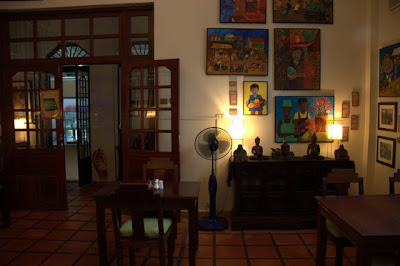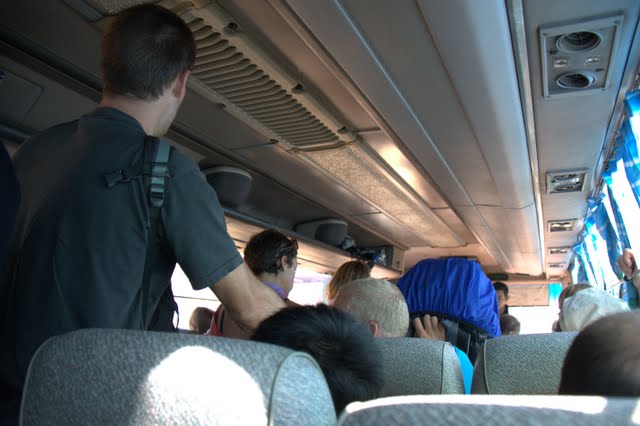Ten Postcards for a Dollar
We were torn about how much time to spend touring Angkor Wat. There are definite advantages of taking it slow, but in the end we made the right decision for us. We bought a three-day pass, but only used it for two days. Honestly, we probably could have seen everything we saw in a day, but spreading it out over two days allowed us to not rush and take a ride out to one of the temples that is further away (Banteay Srei). We had somewhat of a limited timeframe in Cambodia, and spending less time at Angkor Wat allowed us to add in a stop to Battambang. We had no desire to spend more time in Siem Reap; as far as I’m concerned, its only redeeming quality is the passion fruit pastries at Blue Pumpkin. As far as Angkor Wat itself, we liked seeing the ancient ruins, but neither of us are enthusiasts of ancient history and were happy with what we got to see in two days.
Another factor of why we chose to limit our time at Angkor Wat was because the experience was a bit frustrating at times. We tried to time our visits to minimize chances of huge crowds (and admittedly, spreading out our time would have allowed us to do this even more), but we were there at the height of high season and all of the strategies in the world wasn’t going to change the fact that there were just an awful lot of people trying to look at the same things we were trying to look at. The ruins at Angkor are majestic and grand and amazing, especially if you consider people carved them by hand, but the actual experience of looking at them in January 2011? Sean doesn’t agree with me, but I may have enjoyed our time peacefully riding around Sukhothai more.
We’re used to people trying to sell us stuff overandoverandover, but the vendors at Angkor Wat take it to a whole new level. At the Taj Mahal, for instance, people hassle you at the door, and with exception of a guy or two suggesting that you should give him some rupees because of his previous suggestion that you might get a nice reflection of Taj if you take a photo right here, you essentially are left alone until you leave. But at the temples of Angkor, you have to go through the hassling at every single stop you make. It got to the point where I didn’t want our driver (we rented a tuk-tuk to get around) to stop at any of the minor temples because I just didn’t feel like running the gauntlet of people trying to sell me crap I didn’t want or need. We subscribe to the philosophy of killing them with kindness, and always kept our cool despite wanting to scream PLEASE LEAVE ME ALONE, but nothing stopped the barrage of sales tactics besides getting deep enough into the temple such that the person wouldn’t follow you anymore. Except then there’d be a little girl, no more than four, coming at you from around the corner, after being sent over by her mother keeping a watchful eye from afar.
It is no secret that the children in Siem Reap are the hardest to resist. It is one thing to tell an adult no rather brusquely for the tenth time in a row; it is another to do that to a child. We tried striking up a conversation about something other than the postcards or water or books that they are trying to sell you, but these children are onto to such tactics. Some, especially the younger ones, could be swayed, especially if you could figure out a question that wasn’t part of their script, but many were determined to stay on track. You see, they’ve been trained to handle diversionary tactics. They’ll tell you their name, they’ll count from one to ten in English, they’ll tell you your president is Barack Obama and his daughters are Sasha and Malia, they’ll tell you they learned such facts in school, and they’ll tell you they already are done with school for the day. And as soon as they finish with their encyclopedic knowledge of your country, they’ll jump right back into their spiel: so, you buy some postcards, mister? Only ten for a dollar!
One group of little girls followed us for quite a way, well after we tried striking up a conversation and well after we told them firmly that we were not going to buy anything. There were only two originally, but as we walked towards the bathrooms, two others joined in. When I came out of the bathroom, Sean was sitting on a bench, waiting for me, while the group of girls stood as far as they were allowed to go, holding out postcards towards Sean, chanting ten postcards for a dollar, ten postcards for a dollar in deadened, flat voices that sounded like zombies.
I was tempted to grab Sean and run away. Enough is enough; we were not going to buy the stupid postcards, no matter how persistent they were. But it breaks my heart to see children reduced to nothing more than salespeople by manipulative adults. So, I continued chatting with the girls, told them again we weren’t going to buy any postcards, and asked them if they would like to have their picture taken with me, which at least got them to snap out of the zombie act and crack small smiles. But, of course, seconds after showing the girls their picture on my camera, they were back to ten postcards for a dollar, at least with a little more liveliness this time.
Scenes from Phnom Penh
Phnom Penh: a little charming, a little grungy, a little chaotic, but always interesting. Our favorite part of being in Phnom Penh was dining in the plethora of restaurants and cafes run by NGOs. It would be easy to eat every meal in Phnom Penh at such places; save for a couple of meals, we pretty much did. And why not? All of the restaurants we tried had stylish decor and tasty food; the fact that your money goes to a good cause is icing on the cake. We ate at Friends, one of the originals, staffed by former street children and their teachers; Romdeng, started by one of the former waiters at Friends; Cafe Yejj, a cafe employing at-risk women to try to break the cycle of poverty; and Ebony Apsara Cafe & Boutique, where a portion of the proceeds go to re-developing Cambodia’s arts scene. Yum.

We stayed in a guesthouse over a bar run by a Texan ex-pat and his Cambodian wife. Finding a slice of America in Cambodia means you have to take the good (live AFC Championship games, Iron City can spottings, American-style meals) with the bad (Confederate flag displays and Fox News over breakfast).

Also good: the owner's adorable teenage sister who worked the bar after school. She had the biggest dimples and the most outgoing, upbeat personality.

The bustling Russian market, so named for the abundance of Russian goods available during Vietnamese occupation in the eighties. Thanks to the abundance of clothing factories around Phnom Penh, you can find discounted brand name clothes, even in "big sizes, for westerners." I almost bought a Gap dress but declined the temptation at the last minute. The girls at our guesthouse were amazed we didn't buy anything.

A street full of trendy shops, including a chocolatier (with delicious chocolate laced with Kampot pepper)
Welcome to Cambodia: Bribes, Propaganda, and a Compliment
Our entry to Cambodia began, unfortunately, like most people’s: with bribes all around. $1 to the man mysteriously taking our temperatures by pointing a laser at our foreheads as part of quarantine measures, $2 to the man giving us our visa, $2 to the man giving us our entry stamp. Protesting at the border is futile; the officials suddenly don’t know any English and would just send you back to Laos (where, incidentally we had just paid $2 extra dollars for the privilege of leaving). As long as the bribes are low enough tourists keep paying them, and it is not like there is anyone official to whom you can complain – the officials ARE the problem.
We had purchased bus tickets back in Laos to take us across the border all the way to Phnom Penh. After going through the border, we had to board a new bus, which, surprise, didn’t remotely resemble the VIP bus we were promised and shown back in Laos. At least we got seats; apparently Cambodians aren’t worried about things like maximum capacity limits for safety, let along comfort, just like Laotians. For the first two hours of the trip, those unlucky enough to board last got to stand in the aisle, and then were provided with tiny plastic chairs for the remaining 10 hours. Why 12 hours on the bus, you ask? Well, that’s a good question, considering the trip was supposed to take only 9 hours. And one that representatives of the Cambodian bus company answered like all others: it is not our problem, we didn’t promise you anything, take it up with whomever sold you the ticket in Laos.
As an added bonus, the bus company apparently felt we all needed to be educated on the United States’ bombing of Cambodia during the Vietnam War. Which would have actually been fine by me – I had been wanting to learn more about this period of history – if our “education” hadn’t consisted of an extremely unbalanced documentary screeching throughout the bus full of Western tourists at top volume less than ten minutes into our entry into the country. An interesting welcome, for sure.
After many hours of sitting next to a surly American boy who generously shared with me that he couldn’t wait to get to Phnom Penh to finally take a hot shower because he hadn’t showered since he got a tattoo back in Vietnam – TMI, for sure, but something I could have guessed from many hours of sitting in close quarters – and listening to my Ipod on top volume to drown out the ever-present Southeast Asian bus soundtrack, I was ready to get off this bus. Just as we thought we were nearing Phnom Penh, we stopped at a rest stop and were told that actually, we still were at least two hours away. Fantastic. I got myself some fruit from a young girl at the rest stop – fruit being a highlight of Cambodia, we would come to find out – and after I paid for the fruit, the fruit vendor told me I was really pretty. I was pretty sure she had to be lying, considering I had started my day at 5:30, which was many, many hours ago at that point, but I had already paid, and she looked sincere. Hmmmm….maybe Cambodia won’t be so bad, after all.












